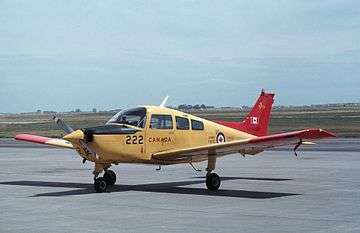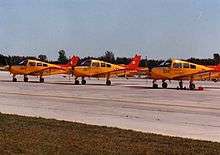Beechcraft CT-134 Musketeer
The Beechcraft CT-134 Musketeer is a military training derivative of the Musketeer built by Beechcraft for the Canadian Forces. The CT-134 was a single engine, low-wing, four-seat light aircraft with fixed landing gear and a limited aerobatic capability.
| CT-134 Musketeer | |
|---|---|
 | |
| CT-134 in 1980 | |
| Role | Basic trainer |
| National origin | United States |
| Manufacturer | Beech Aircraft Corporation |
| Introduction | 1971 |
| Retired | 1992 |
| Primary user | Canadian Armed Forces |
| Number built | 48 |
| Developed from | Beechcraft Musketeer |
Design and development
In the early 1960s the Royal Canadian Air Force’s standard elementary training aircraft was the de Havilland DHC-1 Chipmunk. Flight instruction was completed by student pilots on the DHC-1 before they progressed to the then-brand-new Canadair CT-114 Tutor jet trainer. A decision was made by RCAF HQ to remove the DHC-1s from service and not replace them, as it was felt that the CT-114 was easy enough to fly that initial training was not needed. The CT-114 quickly developed a wash-out rate of near 95% amongst student jet pilots and it was clear that an elementary trainer was needed. Due to the RCAF's previous customer relationship with Beechcraft while operating that company's Expeditor twin-engine aircraft, a hasty purchase of twenty-four B23 Musketeers was made in 1971.[1] The first CT-134 arrived at CFB Portage la Prairie on March 23, 1971.[2]
The new trainers were designated CT-134 Musketeer in the then Canadian Armed Forces. The aircraft purchased were standard Model B23s equipped with the O-360-A4G engine of 180 bhp (130 kW), modified by the addition of a cowling strake, horizontal stabilizer strake and ventral fin to improve spin recovery performance. They were initially serial numbered as 13401-13424, but were re-numbered 134001-134024 to avoid confusion with other CF aircraft serial numbers.[1]
The initial batch of CT-134s was replaced in late 1981 with a purchase of twenty-four more aircraft. These were 1982 model Beechcraft C23 Sundowners and were designated by the CF as CT-134A Musketeer II. These were numbered 134025-134048.[1]
The CT-134 was approved for limited aerobatics, including loops, rolls, chandelles and lazy eights[3]
Operational history

Both batches of Musketeers served with 3 Canadian Forces Flying Training School and the Canadian Forces Flying Instructor School at CFB Portage la Prairie Manitoba and the Canadian Forces Central Flying School in Winnipeg until they were replaced by Slingsby Fireflys operated under contract by Bombardier Aerospace in 1992. During their 21 years of service the CT-134 and CT-134A fleet at 3 CFFTS trained about 5000 Canadian military pilot graduates.
In operational service the CT-134 suffered very few accidents. One of the few serious accidents occurred on 23 March 1990 when Musketeer 134229 had an engine failure on take-off from Erickson Municipal Airport at Erickson, Manitoba, while giving familiarization flights to Royal Canadian Air Cadets. The accident was caused by fuel starvation and the aircraft was written off.[4]
Maintenance of the CT-134 fleet was primarily carried out by the CFB Portage la Prairie Base Aircraft Maintenance Engineering Organization, with Depot Level Inspection and Repair (DLIR) being conducted by Field Aviation at Calgary International Airport in Calgary, Alberta.[4]
Upon retirement the CT-134s and CT-134As were not sold for flying use due to the structural problems they all suffered from years of aerobatics.[5] Instead they were donated to museums or used for air force and civil maintenance training. Some CT-134s still serve as monuments at a few current and former Canadian Forces Bases as well as Royal Canadian Legion halls, a distinction held by very few light aircraft in this class.[1]
In Canadian military service the aircraft was referred to by student and instructor pilots by the nickname Muskrat.[1]
Variants
- CT-134
- Military version of the B23 Musketeer, powered by a Lycoming O-360-A4G powerplant of 180 hp,[3] 24 built.
- CT-134A
- Military version of the C23 Sundowner, powered by a Lycoming O-360-A4K powerplant of 180 hp[6] 24 built.
Military operators
- Canadian Armed Forces/Canadian Forces
- 3 Canadian Forces Flying Training School
- Canadian Forces Central Flying School
- Canadian Forces Flying Instructor School
Specifications
Data from C-12-134-000/MC-000 Operating Checklist Musketeer CT 134, CFTMPC, 10 Jul 79
General characteristics
- Crew: Student and instructor
- Capacity: 2 passengers
- Length: 25 ft 8.5 in (7.85 m)
- Wingspan: 32 ft 9 in (10.00 m)
- Height: 8 ft 2.4 in (2.50 m)
- Wing area: 146 ft2 (13.6 m2)
- Airfoil: NACA 63A415[7]
- Empty weight: 1,560 lb (707 kg)
- Max. takeoff weight: 2,450 lb (normal) / 2,150 lb (aerobatic) (1,110 kg/ 974 kg)
- Powerplant: 1 × Lycoming O-360-A4G air-cooled, 4-cylinder piston engine, 180 hp (136 kW)
Performance
- Maximum speed: 124 knots (231 km/h)
- Never exceed speed: 152 knots (283 km/h)
- Range: 675 miles (1,257 km)
- Service ceiling: 13,000 ft (3,962 m)
- Rate of climb: 880 ft/min (268 m/min)
- Wing loading: 16.8 lb/ft2 (82 kg/m2)
- Power/mass: 13.6 lb/hp (8.2 kg/kW)
See also
Related development
Aircraft of comparable role, configuration and era
- T-41 Mescalero
References
- Air Force Public Affairs / Department of National Defence (2004-04-06). "Beech CT-134 Musketeer". Archived from the original on 2010-12-05. Retrieved 2007-09-17.
- Milberry, Larry: Sixty Years - The RCAF and Air Command 1924–1984, page 384. McGraw Hill Ryerson Canav Books, 1984. ISBN 0-07-549484-1
- DAOT: C-12-134-000/MC-000 Canadian Forces Technical Order Operating Checklist Musketeer CT 134,, CFTMPC, 10 Jul 79
- Milberry, Larry: Aircom: Canada's Air Force, pages 82–83. Canav Books, 1991. ISBN 0-921022-05-0
- AEROWARE / RCAF.com (n.d.). "Beech CT-134 MUSKETEER". Retrieved 2008-04-01.
- DAOT: C-12-134-A00/MC-000 Canadian Forces Technical Order Operating Checklist Musketeer CT 134A,, CFTMPC, 06 Jan 83
- Lednicer, David (October 2007). "The Incomplete Guide to Airfoil Usage". Archived from the original on 15 May 2008. Retrieved 2008-06-28.
External links
| Wikimedia Commons has media related to Beechcraft CT-134 Musketeer. |